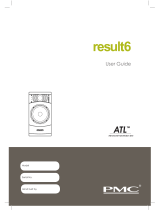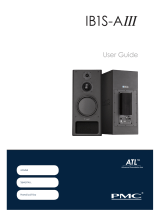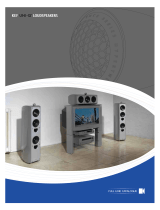Page is loading ...

AUGUST 2021 WWW.HIFINEWS.CO.UK
FEATURE
Class D is hot stuff!
AGD’s Gran Vivace monoblocks
PMC’s fact fenestrias
are towers of power
Exclusive
It’s Majik...
Linn’s iconic Sondek LP12
turntable, in colour!
VAC Sigma 170i
The artisan valve integrated
McIntosh MCD85
CD/SACD spinner with USB DAC
65
YEARS
of Product
Reviews &
Features
UK £5.50 Aus $13.99
• OPINION 12 pages of comment • VINYL RELEASE The Vaccines’ What Did You Expect? on 180g LP
• CLASSICAL COMPANION Brazilian Composers, beyond Villa-Lobos • STUDIO TOURS Hansa Berlin
• VINTAGE REVIEW Philips 551 ‘MFB’ preamplifier • READERS’ CLASSIFIEDS Hi-Fi bargains galore
V
I
N
Y
L
I
C
O
N
R
E
V
I
E
W
DEEP PURPLE
IN ROCK

LOUDSPEAKER
www.hinews.co.uk | Reprinted from Hi-Fi News for global distributionReprinted from Hi-Fi News for global distribution | www.hinews.co.uk
Three-way, six-driver floorstanding loudspeaker
Made by: The Professional Monitor Company Ltd
Supplied by: PMC Ltd
Telephone: 01767 686300
Web: www.pmc-speakers.com
Price: £54,995
The PMC fact fenestria – the British
brand’s agship ‘domestic’ speaker
(note lower case f) – was launched
at a packed press conference at
Munich’s High End Show. That’s the 2018
High End Show, and it’s taken over three
years for it to arrive for review – in which
time the price has risen from the inaugural
£45,000 to the £54,995 for the pair you
see here. In the intervening period there’s
actually only been one Munich show – that
in 2019, at which the company launched
its smaller ‘fact signature’ models: the
2020 show fell victim to the pandemic,
as did this year’s at least twice, being
rescheduled from May to September, then
cancelled completely.
All that while we’d
been wondering what
had happened to the fact
fenestria speakers, which
take their name from the
idea of an open window on
the music or, as PMC put it
at the launch, ‘the speakers
you’ll never hear’. Yes, we get the idea of
neither adding to, nor subtracting from,
the sound, but for years they were truly
living up to that never-to-be-heard billing.
FLOAT ON
Anyway, now they’re here, and still pretty
imposing at 1.7m tall, and weighing a
healthy 80kg apiece complete with their
stabilising plinth. Expert installation is
required, not just because of the size and
weight of the things, but because the
construction of the speaker involves a lot
of assembly work on delivery. The speaker
involves two bass cabinets – one sitting on
that substantial plinth, the other inverted
on top, plus a oating metal section, called
the Nest. This slots into a cutout formed
by those two assemblies, on which are
mounted the tweeter and midrange driver.
Even then you’re not done, as the outer
‘cabinet’ of each speaker is formed by four
‘planar wings’. Far from decorative, these
are part of the mechanics of the entire
assembly, acting as tuned mass dampers
to tackle resonances [see PM’s interview
RIGHT: The 19.5mm soft dome treble and
75mm soft dome mid are isolated from the main
cabinet by a separate, hourglass-shaped bafe.
Pairs of transmission line-loaded 165mm bass
units, with at carbon-bre/cell foam sandwich
diaphragms, are mounted above and below
Launched three years ago but only now released for
review, PMC’s agship fenestria is a towering statement
Review: Andrew Everard & Paul Miller Lab: Paul Miller
PMC fact fenestria
‘The crossover
is massive and
complex, filling
the plinth’
with designer Oliver Thomas, p43]. But at
its heart, the fact fenestria is a relatively
simple speaker – a three-way design with
elements, although all-new here, familiar
from other PMC models. The tweeter is a
19.5mm version of the company’s long-
running Sonomex design, with a soft dome
and neodymium magnet, mounted in a
36mm surround, itself isolated by a silicon
mount PMC calls an ‘Aureole’.
SHAKEN NOT STIRRED
The tweeter shares that ‘Nest’ assembly,
which is open-backed, milled from a
billet of aluminium and shaped both to
avoid bafe diffraction and isolate the
whole assembly from the
bass ‘bins’, with a rear-
chambered development
of the company’s famous
75mm soft-dome
midrange driver. The new
version uses a cotton
dome rather than the silk
of past designs, as does
the tweeter, here doped with a revised
chemical cocktail. This is said to give better
stiffness as well as lightness, while any
unwanted rear energy vents into a tuned
chamber [see PM’s boxout, p41].
The bass section – or rather sections
– of each speaker demonstrate familiar
PMC thinking, using the company’s ATL
(Advanced Transmission Line) loading,
venting out via Laminair ports. The latter
are tuned using Oliver Thomas’s knowledge
of airow gained during his time spent
working in F1 engineering. Rather like the
diffusers used on racing cars, this design
is all about smoothing airow. For the fact
fenestra, both the geometry of the ATL and
the choice of lining materials within the
‘tunnel’ have been rened. So no major
changes to the thinking here, but tweaks.
Front and centre of the tall,
elegant fenestria is the PMC75-S
midrange dome, a development of the iconic
PMC75 used in PMC’s active studio monitors and SE Home
models for years. Previously, PMC had damped internal resonances
immediately to the rear of the dome but has greatly improved this in the
PMC75-S by using a vented (hollow) pole-piece to dissipate rear-radiated
energy into a separate chamber. The latter extends out from behind
the motor structure, its computer-modelled prole spun from a single
piece of aluminium. A bitumastic material coats the inside of the chamber
together with multiple layers of acoustic foam to absorb the unwanted rear output
of this mid driver. Reduced distortion and improved response ‘atness’ are the key
benets, the latter also enhanced by the re-designed, two-part 150mm magnet and
motor design with its copper shorting ring.
The dome driver itself is made from cotton, impregnated with a plasticised
lacquer to combine light weight with a high degree of self-damping. A dual
suspension/surround, also fashioned from a doped cotton but with a tighter
weave, permits greater displacement without rocking – read higher SPLs with
lower distortion. The entire midrange assembly is isolated from any main cabinet
vibrations by PMC’s ‘Nest’ – a proled, machined aluminium frontispiece mounted
onto the cabinet with silicone bushes. The compliance operates over three axes and
is tuned to be effective down to very low frequencies, claims PMC. PM
GRAND DOME
a series of multipin connectors between
plinth, enclosures and Nest. The crossover
points are at 380Hz from the bass to the
midrange, and 3.8kHz from midrange
to tweeter. The company provides a
couple of adjustments to the rear of
the plinth, allowing the treble and bass
each to be subtly adjusted. Three sets of
substantial spanner-friendly rhodium-plated
combination terminals are provided with
jumper bars to allow single-, bi- or tri-
amping/tri-wiring, and high-quality –
and very sharp! – spikes are provided.
SOLID ROCK
The fact fenestria speakers certainly make a
statement in any room, even though they’re
not as big as some pictures might suggest.
They’re relatively slender at just 37cm wide,
and PMC says the ATL design means they’re
not fussy about positioning, and should
be used with a slight toe-in to rm up the
image. I’d advise the usual cautions about
using them in corners or equidistant from
walls, but they do seem very room-friendly.
And, of course, those controls down on the
crossover do allow a modicum of room-
tuning – though I’d go easy with the bass
boost, however tempting it may seem.
As far as the listening position is
concerned, things are similarly simple – just
ignore that big bass-box on the top, and
sit with your ears on the same level as the
Nest midrange assembly, and you won’t
go far wrong. In that position the fact
fenestrias sound similar to, but rather better
than, a good two- or three-way speaker
However, while ATL and the Laminair
ports are found in other PMC designs,
the bass drivers here are all-new, and
developed purely for this speaker. The
16.5cm at-diaphragm ‘piston drivers’
use a membrane comprising carbon bre
layers sandwiching a Rohacell foam core.
These are driven by 14cm magnets, and
are mounted between the main enclosure
and a decoupled secondary bafe, which
oats on a magnetic suspension sealed with
a gasket. The enclosures themselves use a
range of thicknesses of HDF (High-Density
Fibreboard), from 18mm up to 30mm, this
also forming the internal 2.4m-long ATL
labyrinth as a structural part of the cabinet
assembly [see illustration, p41].
Those planar wing panels, available in
Tiger Ebony, Rich Walnut or White Silk,
attach to the sides of the bass enclosures via
oating mounts, allowing them to damp out
resonances by vibrating in opposition to the
main speaker. The technology, echoing that
used to stabilise tall buildings in earthquake
zones, creates an effect PMC says operates
down into the lower midrange, and also
helps reduce room interactions. Having
once been resident on a high oor of a hotel
when a – mercifully small – earthquake
struck, I get the principle. Amid the shaking
there was a denite sense of a great
mass literally swinging into action up
above to calm things down.
The crossover here is massive and
complex, lling the plinth, which is
CNC-routed from a single piece of HDF, and
connecting out to the driver sections via

www.hinews.co.uk | Reprinted from Hi-Fi News for global distribution
from the company’s main fact range and
with a hefty dose of bass to underpin
goings-on. We’ve had some big speakers
through our hands demonstrating much
more ‘character’ – for good or bad – than
the fact fenestrias make obvious, but
there’s little chance you’ll
consider these speakers
to be inauspicious or just
plain ordinary on your rst
acquaintance with them.
One point worthy of
consideration, however, is
PM’s observation regarding
the sensitivity of the
speakers [see Lab Report, p45]. While
they present a relatively easy-going 6ohm
nominal load, they fall some way short of
the quoted 86dB/2.83V/1m, suggesting
some decent amplier power won’t go
amiss. I imagine that some of the larger
Bryston power ampliers were employed
in the development here – PMC distributes
the Canadian brand in the UK – and this
may explain why even with the Classé Delta
Pre/Mono amps [HFN Jun ’21] in harness,
I was aware of having to crank the level
on the preamp pretty hard to stir the fact
fenestra speakers into life.
Given the power on tap from the Classé
amps – PM measured 400W/8ohm and
760W/4ohm – this is clearly something
to be considered. It’s not just a matter of
needing high-quality amplication for these
speakers as high power is required, too.
Given that power, the fact fenestrias
can certainly deliver, rocking out with the
raw southern swagger of the title track
of Blackberry Smoke’s You Hear Georgia
set [3 Legged Records 3LG14CD]. There’s
ne instrumental denition and speed, all
underpinned with a big, solid bass thump,
and impressive soundstaging.
GROOVE KINGS
The same is true with the latest Crowded
House set, Dreamers Are Waiting [EMI
3534658], the loudspeakers giving ne
insight into the performances. They lurch
appealingly into ‘Playing With Fire’ with
real drive, and just as easily slip into the
easy groove of ‘Start Of Something’,
the beautiful harmonies on this song
persuasively rendered to draw the listener
into the very heart of the music.
Similarly, these speakers grab your
attention with the vocals on Paula Cole’s
American Quilt album [BMG 538668572],
set against superb, if spare, backing and
with ne ambience. And when the fact
fenestrias get the opportunity to show
their scale and weight, as in the rened yet
dramatic performance of Walton’s Crown
Imperial, from the Dallas Wind Symphony’s
album of the same title
[Reference Recordings RR-
112], they can delight.
They deliver detail
deep into the orchestra –
twinkling tuned percussion
and glorious woodwind
and brass timbre, but for
all their size these never
sound like big, slow speakers. Instead,
they’re fast and agile, while still capable
of massive slam. The slow processional
theme has richness and weight and the
great percussion crump at the end of that
section shakes the room. Fabulous stuff.
‘They are fast
and agile,
combined with
massive slam’
Commercial Director and CTO, Oliver
Thomas, kick-started the fenestria
project in 2013 as an exercise in
‘blue sky thinking’. PMC’s iconic
midrange dome was to remain at the
heart of the speaker but it was also
an opportunity to evolve its design.
Improving the dissipation of the
dome’s rear radiation was key [see
boxout, p41], so did PMC look at the
frequency-selective metamaterial
approach to damping seen in KEF’s
LS50 Meta [HFN Jun ’21]?
‘Not directly’, admits Oliver,
‘though we do have a parallel
technology in development’. The
design goals for the fenestria were
arguably broader in scope, both
in reducing driver distortion and
minimising cabinet noise.
For example, the curved side
panels act as tuned mass dampers,
working in anti-mode to the main
cabinet resonances. ‘These panels
are working hardest below 100Hz’,
reveals Oliver, ‘and we have chosen
the compliance of the rubber
mounts, in tandem with the mass of
the curved panels, to best achieve
this. The position of the mounts is
critical too, situated at points of
maximum displacement’.
Where does the fenestria take
PMC? ‘There’s new tech, including
a smaller mid dome already used in
our ci140 on-wall speakers. Also the
anti-vibration mounts inspired the
decoupling between the cabinet
and plinth in our twenty5i series.
The bass units are so expensive to
manufacture there’s a limit to what
we can put them into’, laughs Oliver,
‘but there’s a deal of learning here
that’ll inevitably trickle down into
our domestic designs’. PM
OLIVER THOMAS
LEFT: The fenestria is divided into two mirror-
image cabinets where the pairs of 165mm
cellular/carbon-bre bass ‘piston drivers’ feed
into folded 2.4m transmission lines that exit at
the very top and bottom of the enclosure

www.hinews.co.uk | Reprinted from Hi-Fi News for global distribution
the instrument convincingly scaled
without being unnaturally close-up.
But then that’s the hallmark of these
speakers – they have all the weight
and solidity of those multiple bass
drivers, without ever sounding
over-large or ponderous.
STATELY SOUNDS
This is apparent with the Band Of
Brothers’ set A Jazz Celebration Of
The Allman Brothers Band [New West
Records NW6474]. It’s a concept
that sounds like it shouldn’t work,
but it does, the jazz musicians
charging through ‘Whipping Post’,
thanks in no small part to the fact
fenestria’s combination of weight,
information and speed, driving the
rhythms thrillingly. The sound is big
and punchy, with really powerful,
characterful brass.
And that attention to detail is
once more reinforced with John
Challenger’s atmospheric Salisbury
Meditation album [AJM AJM001,
96kHz/24-bit], helped by the way
these speakers cast the organ
slightly distant in the acoustic, just
as it should be. The impression of
walking into a cathedral and hearing
the instrument playing, rather than
a close-up view, is highly persuasive
with Albinoni’s ‘Adagio’. It’s a great,
unforced, stately sound, complete
with the resonances of the space,
and a ne exemplar of what the fact
fenestria can achieve.
LEFT: PMC’s three-way 380Hz/3.8kHz
split crossover supports tri-amping and
tri-wiring if the link plates are removed
from the trio of chunky cable connectors.
Subtle ±LF and ±HF bass/treble tone
adjustment is possible at 90Hz and 2kHz
These agships manage to sound
suitably big and weighty, without
any of the excessive bloom or
slowness one might expect from
those two hefty bass bins on each
channel. It’s a striking piece of
engineering, and delivers speed
and detail, along with exceptional
soundstaging and an involving
effortless listen. Just don’t stint
on the amplication, for these
speakers need plenty of grip and
power to be heard at their best.
HI-FI NEWS VERDICT
Sound Quality: 88%
0 - - - - - - - - 100
However, you don’t need massive
musical forces to hear what these
speakers can do. With Martha
Argerich’s legendary 1965 recording
[Warner Classics 9029669767,
192kHz/24-bit], the pianist, then
just 24, plays with vivacity and
wonderful expression, and there’s
a great sense of ambience around
the piano in the studio, plus speed,
attack and lightness of touch all at
once. The imaging is rock solid, and
HI-FI NEWS SPECIFICATIONS
HI-FI NEWS SPECIFICATIONS
0
-7
-14
-21
-28
-35
dB
0.0
1.3
2.7
4.0msec
200 500 1k 2k 5k 10k 20k 60kHz
Frequency in Hz >>
ABOVE: Cabinet is fairly ‘silent’ leaving a bass driver
mode at ~1kHz and minor dome modes at 5kHz–8kHz
ABOVE: Response inc. neareld summed driver/port
[green], freeeld corrected to 1m at 2.83V [yellow],
ultrasonic [pink]. Left, black; right, red; ±HF, blue
Sensitivity (SPL/1m/2.83V – 1kHz/Mean/IEC) 82.0dB / 82.7dB / 81.3dB
Impedance modulus: minimum
& maximum (20Hz–20kHz)
4.7ohm @ 81Hz
11.6ohm @ 255Hz
Impedance phase: minimum
& maximum (20Hz–20kHz)
–32o @ 29Hz
+25o @ 160Hz
Pair matching/Resp. error (200Hz–20kHz) 1.3dB/ ±3.1dB/±3.3dB
LF/HF extension (–6dB ref 200Hz/10kHz)
33Hz / 26.8kHz/25.9kHz
THD 100Hz/1kHz/10kHz (for 90dB SPL/1m) 0.25% / 0.09% / 0.9%
Dimensions (HWD) / Weight (each) 1700x370x623mm / 80kg
LAB
REPORT
PMC FACT FENESTRIA
For the size of cabinet, the fenestria’s 86dB rated sensitivity is
not especially high and, in practice, turns out to be substantially
lower on test at 82dB/1kHz, increasing to 82.7dB when
averaged across 500Hz-8kHz. Thankfully the speaker is a complex
but not especially tough 6ohm nominal load to drive. There’s
a 4.7ohm/81Hz minimum and despite the load remaining sub-
8ohm from 8Hz-170Hz, 370Hz-2.7kHz and above 4.6kHz, the
largest phase angles are a very modest +25o/–32o. High SPLs will
still demand a high power amplier but, despite the diminished
sensitivity, THD is low at ~0.25% through the bass and very low
through the passband of the dome mid at ~0.1% (re. 90dB SPL).
Driver modes are very well controlled too [see CSD Graph 2].
The ideal listening axis, on the mid dome, is not far off the
‘average’ seated height but if you sit higher (towards the treble
dome) then the response dips between 2kHz-5kHz (–3.7dB/
4.6kHz). This effect was more obvious with one speaker, hence
the 1.3dB pair matching (tightening to 0.5dB, 200Hz-3kHz and
5kHz-20kHz). Otherwise the forward trend has a mild ‘BBC dip’
with a lift above 8kHz responsible for the ±3.1dB and ±3.3dB
response errors, followed by some lobing above 20kHz [pink
shaded area, Graph 1]. PMC’s useful HF control operates above
2kHz [blue traces, Graph 1] tilting up/down to reach a sensibly
modest, but certainly audible, ±1.1dB above 6kHz. Meanwhile,
the quartet of bass drivers peak at 79Hz (40Hz-425Hz, –6dB),
augmented by the folded transmission lines at 22Hz-136Hz to
deliver a low, corrected LF extension of 33Hz [–6dB re. 200Hz;
green shaded area, Graph 1]. PM
/











